 W
WApodemia mormo langei, the Lange's metalmark butterfly, is an endangered North American butterfly. It is a subspecies of the Mormon metalmark and belongs to the family Riodinidae. The butterfly is endemic to California, where it is known from one strip of riverbank in the San Francisco Bay Area. A 2008 count estimated the total remaining population at 131 individuals. Since 2011, this number has dropped to about 25–30.
 W
WArhopala allata suffusa, the Tytler's rosy oakblue, sometimes placed in Amblypodia, is a small subspecies of butterfly found in India that belongs to the lycaenids or blues family.
 W
WArhopala paraganesa felipa is a butterfly of the family Lycaenidae first described by Gerardo Lamas in 2008. It is a subspecies of Arhopala paraganesa. It is found on Palawan Island in the Philippines. It is rare. Forewing length is 13-14.5 mm (male); 13-14 mm (female).
 W
WBattus philenor hirsuta, the California pipevine swallowtail or hairy pipevine swallowtail, is a subspecies of the pipevine swallowtail that is endemic to Northern California in the United States. The butterfly is black with hindwings that have iridescent green-blue coloring above and a row of red spots below; the caterpillars are black with fleshy protrusions and orange spots. The subspecies' butterflies are smaller in size and hairier than the species, and they lay eggs in larger clutch sizes than the species. The egg clutches are deposited on the shoot tips of the California pipevine, a perennial vine native to riparian, chaparral, and woodland ecosystems of the California Coast Ranges, Sacramento Valley, and Sierra Nevada foothills. The larvae feed exclusively on the foliage and shoot tips of the pipevine, although adults eat floral nectar from a variety of plants. The plant contains a toxic substance, aristolochic acid. The larvae sequester the toxin, and both the juvenile and adult butterflies have high and toxic concentrations of the aristolochic acid in their tissues. Throughout the range of the species, Battus philenor, other butterflies and moths mimic the distinctive coloration of the swallowtail to avoid predators. However, there are no known mimics of the Californian subspecies.
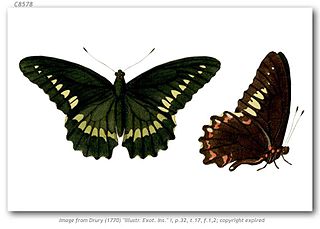 W
WBattus polydamas antiquus is an extinct subspecies of the Polydamas swallowtail within the butterfly family Papilionidae. It is only known by a drawing from 1770 by British entomologist Dru Drury. It was endemic to Antigua.
 W
WThe Bay checkerspot is a butterfly endemic to the San Francisco Bay region of the U.S. state of California. It is a federally threatened species, as a subspecies of Euphydryas editha.
 W
WThe callippe silverspot butterfly is a federal endangered species in the brush-footed butterfly family Nymphalidae. This is a subspecies. It is a member of the Heliconiinae, the subfamily known as longwings. The adult has a wingspan of just over two inches. The wings are eyecatching with a brown, tan, and black scalloped pattern on their surfaces and orange-brown with characteristic silver spots on the undersides. The wings and abdomen are hairy. The larvae are spiny, dark-colored caterpillars.
 W
WCatapaecilma evansi shizukoae is a subspecies of butterfly of the family Lycaenidae. It is found in Indonesia (Nias).
 W
WCethosia hypsea hypsina, the Malay lacewing, is a subspecies of Cethosia hypsea, a butterfly of the genus Cethosia belonging to the family Nymphalidae.
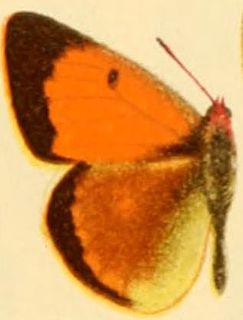 W
WColias caucasica balcanica is a butterfly in the family Pieridae. It is the European subspecies of Colias caucasica. It is found in Bosnia and Herzegovina, Bulgaria, Serbia, Montenegro, North Macedonia and Greece. It used to be considered a distinct species.
 W
WCyrestis camillus elegans is a butterfly subspecies in the genus Cyrestis and the family Nymphalidae. It is known from Madagascar.
 W
WDrupadia theda nobumasai is a subspecies of butterfly in the family Lycaenidae. It is found in Indonesia (Simeulue).
 W
WThe El Segundo blue is a rare subspecies of the square-spotted blue butterfly. It is endemic to a small dune ecosystem in Southern California that used to be a community called Palisades del Rey, close to the Los Angeles International Airport (LAX). In 1976 it became a federally designated endangered species. This butterfly’s habitat has been substantially reduced due to urban development and invasive plants, and it now exists as a handful of populations restricted to coastal dunes in the vicinity of Los Angeles.
 W
WEuchloe ausonides insulanus, the island marble butterfly, is a subspecies of butterfly found in the San Juan Islands in Washington in the northwestern United States.
 W
WEuphydryas editha taylori, the Whulge checkerspot or Taylor's checkerspot, is a butterfly native to an area of the northwestern United States and Vancouver Island.
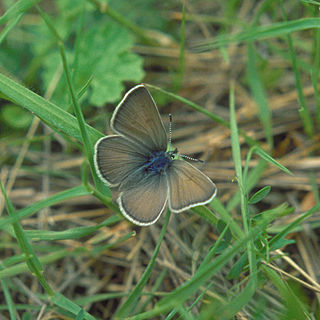 W
WFender's blue butterfly is an endangered subspecies of Boisduval's blue endemic to the Willamette Valley of northwestern Oregon, United States. The potential range of the butterfly extends from south and west of Portland, OR to south of Eugene, OR. The butterfly is host-specific on the Kincaid's lupine, which it relies on for reproduction and growth.
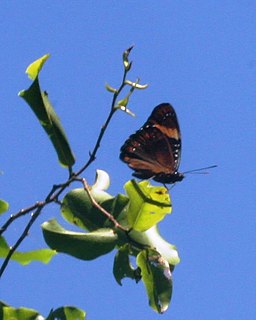 W
WHypolimnas octocula marianensis, known as the Mariana eight-spot butterfly or forest flicker, is a subspecies of Hypolimnas octocula, the eight-spot butterfly.
 W
WIcaricia icarioides blackmorei, the Puget blue, is a butterfly native to the Puget Sound area in the northwestern U.S. state of Washington. It is a subspecies of Boisduval's blue.
 W
WThe Karner blue is an endangered subspecies of small blue butterfly found in some Great Lakes states, small areas of New Jersey, the Capital District region of New York, and southern New Hampshire, where it is the official state butterfly. The butterfly, whose life cycle depends on the wild blue lupine flower, was classified as an endangered species in the United States in 1992.
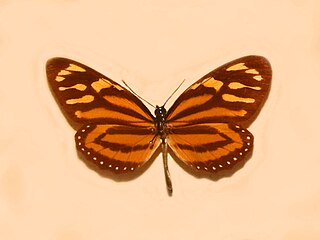 W
WLycorea halia atergatis, the tropical milkweed butterfly, is a subspecies of Lycorea halia, also called the tropical milkweed butterfly, a nymphalid butterfly family in the Danainae subfamily. It is found from Mexico, Venezuela and Colombia. Its habitat is tropical rainforest. It is sold commercially to collectors.
 W
WLycorea halia cleobaea, the tropical milkweed butterfly, is a subspecies of Lycorea halia, also called the tropical milkweed butterfly, a nymphalid butterfly in the Danainae subfamily. It is found from the Antilles, Dominican Republic and the Caribbean. Its habitat is the tropical rainforest.
 W
WLycorea halia halia, the tropical milkweed butterfly, is a subspecies of Lycorea halia, also called the tropical milkweed butterfly, a nymphalid butterfly in the Danainae subfamily. It is found from Suriname, French Guiana and Peru to the Caribbean. Its habitat is tropical rainforest.
 W
WThe Madeiran large white is a subspecies of the large white, endemic to Madeira. It can reach a size of 55 to 65 millimetres. The wings are pure white with a wide black tip on the apexes of the forewings. Its natural habitat is the laurisilva laurel forest. Considering that it was last collected in 1977 but not found despite a 15-year survey during the 1980s and 1990s, it might be either extremely rare or possibly extinct. One reason for its decline might be a virus infection which brought out after the small white was introduced to Madeira in the 1950s. Another reason for the decline is due to the introduction of the wasp parasitoid. The wasp parasitoid was last discovered in the western Canary Islands in May 2006. It uses pieridae as a host and is commonly found where pieridae species are in abundance. The scientific name commemorates Thomas Vernon Wollaston, an entomologist who has discovered several insect taxa on Madeira.
 W
WThe Miami blue is a small butterfly that is native to coastal areas of southern Florida. It is a subspecies of Thomas's blue. Once common throughout its range, it has become critically endangered. Its numbers have recently been increased by a captive breeding program at the Florida Museum of Natural History.
 W
WMiletus chinensis longeana, or Long's brownie, is a small but striking subspecies of butterfly found in India and Myanmar that belongs to the lycaenids or blues family.
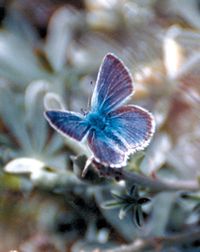 W
WThe Mission blue is a blue or lycaenid butterfly subspecies native to the San Francisco Bay Area of the United States. The butterfly has been declared as endangered by the US federal government. It is a subspecies of Boisduval's blue.
 W
WMyrtle's silverspot is a medium-sized butterfly in the brush foot family (Nymphalidae), an endangered subspecies of the zerene fritillary. It is endemic to California, where it is known from only about four locations just north of the San Francisco Bay Area, including two at Point Reyes National Seashore. Its wingspan is approximately 2.2 inches (56 mm). The upper surfaces of the wings are golden brown with numerous black spots and lines. The undersides are brown, orange and tan with black lines and silver and black spots. Larvae are dark colored with many sharp branching spines on their backs. Myrtle's silverspot is larger and paler than the closely related Behrens' silverspot, which is now limited to the vicinity of Point Arena in Mendocino County.
 W
WThe Palos Verdes blue is a small endangered butterfly native to the Palos Verdes Peninsula in southwest Los Angeles County, California, United States. As its distribution has been proven to be limited to one single site it has one of the best claims to being the world's rarest butterfly.
 W
WThe Oregon swallowtail is a subspecies of swallowtail butterfly native to the United States of America, Oregon, Washington, and Idaho and south-central British Columbia in Canada. In 1976, it became one of the first four butterflies that the United States Postal Service placed on a U.S. stamp.
 W
WPapilio paris tamilana, the Tamil peacock, is an endemic swallowtail butterfly found in southern India. It is a subspecies of Papilio paris, the Paris peacock.
 W
WParnassius staudingeri hunza, the Karakoram banded Apollo, is a high-altitude butterfly which is found in India. It is a member of the genus Parnassius of the swallowtail family, Papilionidae. It was variously treated as a subspecies of P. delphius and a distinct species. The subspecies was first described by Grigory Grum-Grshimailo in 1888.
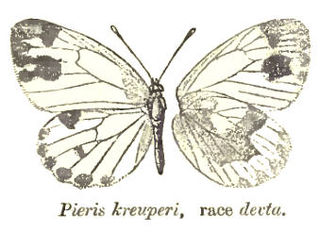 W
WPieris krueperi devta, the green-banded white, is a small butterfly of the family Pieridae, that is, the yellows and whites. It is found in India and Pakistan. It is a subspecies of Krueper's small white.
 W
WPoritia philota simoncolini is a butterfly of the family Lycaenidae. This subspecies of Poritia philota was first described by Hisakazu Hayashi and Noel Mohagan in 2017. It is found only on Mt. Baco of Mindoro island in the Philippines. Its forewing length is 14–17 mm. It is distinguishable from the subspecies P. p. mindora from Mt. Halcon on Mindoro Island by the markings of the upperside and underside.
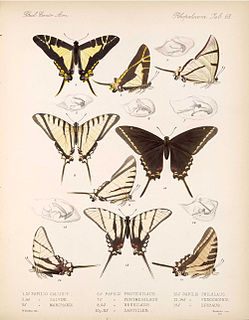 W
WProtographium agesilaus neosilaus, the short-lined kite swallowtail, is a subspecies of butterfly in the family Papilionidae. It is found in Mexico and Central America. The subspecies was first described by Carl Heinrich Hopffer in 1866. Specimens are sold commercially to collectors.
 W
WProtographium dioxippus lacandones, the thick-border kite swallowtail, is a subspecies of butterfly of the family Papilionidae. It is found in Mexico and Central America. The subspecies was first described by Henry Walter Bates in 1864.
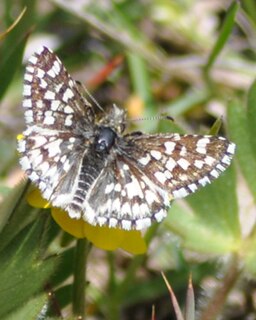 W
WPyrgus ruralis lagunae, the Laguna Mountains skipper, is a butterfly of the family Hesperiidae. It is a subspecies of Pyrgus ruralis.
 W
WThe Quino checkerspot is a butterfly native to southern California and northwestern Baja California. It is a subspecies of the common Edith's checkerspot and the second such subspecies to be listed under the federal Endangered Species Act.
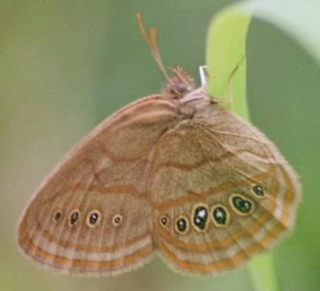 W
WThe Saint Francis' satyr is an endangered butterfly subspecies found only in the US state of North Carolina. First discovered in 1983, it was first described by David K. Parshall and Thomas W. Kral in 1989 and listed as a federally endangered species by the US Fish and Wildlife Service in 1994. It is a subspecies of N. mitchellii and is restricted to a single metapopulation on Fort Bragg military base in Hoke and Cumberland counties. The other subspecies, Mitchell's satyr, is also federally endangered.
 W
WThe Sand Mountain blue is a lycaenid butterfly of the "blue" subfamily that is only found around the Sand Mountain Recreation Area near Fallon, Nevada. It is a subspecies of the pallid blue.
 W
WSimiskina phalena hayashii is a subspecies of butterfly in the family Lycaenidae. It is found in the Philippines. The subspecies was first described by Heinz G. Schröder and Colin G. Treadaway in 1979.
 W
WSmith's blue butterfly, Euphilotes enoptes smithi, is an subspecies of butterfly in the family Lycaenidae. This federally listed endangered subspecies of Euphilotes enoptes occurs in fragmented populations along the Central Coast of California, primarily associated with sand dune habitat in one case with a dune-based Maritime Coast Range Ponderosa Pine forest in the Carbonera Creek watershed in Santa Cruz County. The range of E. e. smithi is from Monterey Bay south to Punta Gorda.
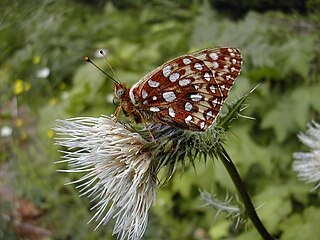 W
WSpeyeria zerene hippolyta, the Oregon silverspot, is a threatened butterfly that is found in the U.S. states of California and Oregon. It is a subspecies of Speyeria zerene.
 W
WTajuria deudorix yuhkichii is a subspecies of the butterfly Tajuria deudorix in the family Lycaenidae. The subspecies was first described by Hisakazu Hayashi in 1984. It is found in Palawan in the Philippines.
 W
WTajuria matsutaroi motokoae is a butterfly of the family Lycaenidae. It is a subspecies of Tajuria matsutaroi. This subspecies is rarely found on Leyte island in the Philippines. Its forewing length is 16–19 mm. Subspecies motokoae is distinguishable from the nominotypical subspecies by the following characters of the upperside: 1) ground colour is decidedly darker and clearly tinged with purple, while only slightly tinged with pale purple in subspecies matsutaroi, 2) black border is broader in spaces 1b, 2 and the upper part of the cell on the forewing, 3) in the female, the upperside costal area is blackish, whereas it is whitish in subspecies matsutaroi.